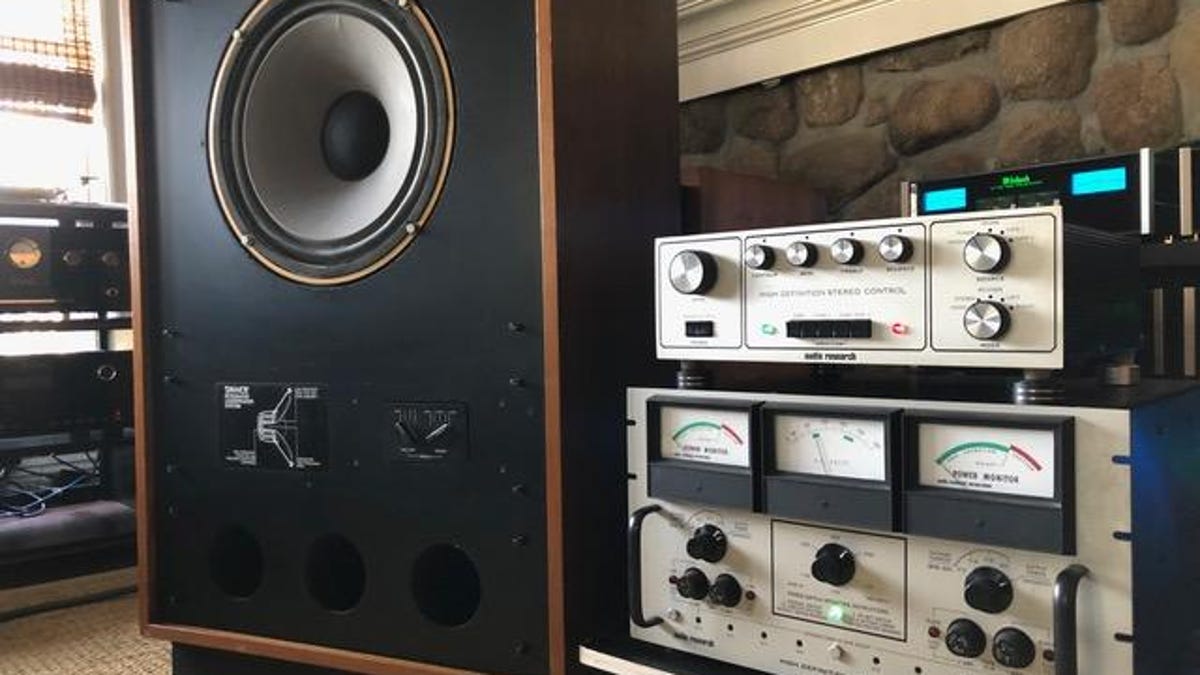This 1970s audio system sounds better than what you're listening to today
The Audiophiliac's deep dive into vintage audio leaves him shaken, rattled and rolled.
I've sometimes wondered how today's audiophile gear compares with its vintage counterparts. The best of today's high-end audio is spectacular, but how much progress really has been made? To find out I tapped SkyFi Audio -- it buys, tests and sells used audio, and I asked the folks there to put together a vintage high-end system. The 1970s seemed like the right decade to journey back to.
Right after the plan was set in motion I worried "what if vintage audio is just a nostalgia trip, hopelessly outclassed by today's gear?" Can components designed when Gerald Ford was president sound any good?
I shouldn't have been concerned. Listening to the SkyFi system the sound was above all authentic. It hadmore substance, soul and body than most 21st century audio systems. Despite all the advances in tech and materials since the 1970s, today's speakers sound a little undernourished next to this vintage setup.
A blast from the past
SkyFi offered a range of choices for my fantasy system, but I wanted to stay in the '70s, the golden age of high-end audio. I selected a Garrard 401 turntable, outfitted with a new Absis 1.0 tonearm and Sumiko Amethyst phono cartridge. The Garrard 401 debuted in 1965 and remained in production through 1977, so it's ideal for my dream 1970s system.
The Garrard 401 turntable was mounted in a new custom-made plinth sourced from the UK. The turntable and arm's current retail price is $5,999 (about £4,500 or AU$8,500), not including a cartridge. This 'table is neither belt- or direct-drive, it's an idler drive, the type favored by vintage audio turntable aficionados.
The Garrard 401 turntable.
One of my first high-end preamplifiers was an Audio Research SP-6B, but I went for an even older, all-tube Audio Research SP-3A preamp. Like all preamps of the era it had a built-in moving-magnet phono stage. The SP-3 debuted in 1972, and this one looks and sounds pristine. SkyFi is selling it for $2,699.
I also owned an Audio Research Classic 30 tube power amp back in the day, so how could I resist an Audio Research D-150 amplifier, one of only 200 made between 1975 and 1977. The all-tube design delivers 150 watts per channel, and it weighs 115 pounds (52 kg)! The listed price is $9,999. It was expensive when new, but since it's built to last and sound great 40+ years on, it's still expensive.
The Audio Research SP-3-A preamp (top), Audio Research D-150 (bottom).
The speakers were the magnificent and very large Tannoy Ardens from the mid-1970s, which feature a gigantic dual-concentric 15-inch paper pulp woofer with a 1.3-inch aluminum-magnesium alloy dome tweeter behind the dust cap. This pair's price is $3,499, and I'm happy to see Tannoy revived Arden production -- it's now called the Arden Legacy ($8,000 a pair). It's a near clone of the vintage speaker I auditioned.
The Tannoy Arden speaker
The large and very heavy system was transported from SkyFi's New Jersey facility to the Stereo Exchange store in New York for my auditions. I wasn't all that sure what to expect. Would the system be totally outclassed by 21st century audio?
I'll cut to the chase right now: Few new audiophile systems today at this price can compete with the SkyFi Audio system in terms of impact, scale and power. The vintage system was big and gutsy, and sounded incredibly powerful.
I brought along a few older LPs to get acquainted with the sound, and Pink Floyd's Relics album's psychedelic freakout, Interstellar Overdrive, set my mind reeling. I started listening from about 8 feet (2.4 meters) away from the speakers and liked the sound, but then moved out another 8 feet and the sound just got better and bigger, and closer to life-size. Lesson learned: Big speakers like these need room to breathe. I kept moving further away from the speakers and loved the way the sound filled the store.
Then Giorgio Moroder's pulsing synth score for the 1982 movie Cat People, taken at high volume again demonstrated what these big old speakers can do. They move a lot of air. David Bowie supplied the blistering opening track, Putting Out Fire, and his raw vocal was downright frightening.
After that I needed to calm down, and Nat "King" Cole's After Midnight album made me sit up and take notice of the system's midrange. The vocals sounded full-bodied in ways no contemporary pint-size bookshelf, tower or panel speaker can replicate. They all miniaturize and compress vocals' tone and dynamics.
When I returned home and listened to some of the same LPs with my SME Model 15 turntable, Pass Labs preamp, First Watt amplifier and Klipsch Forte III speakers, the sound was more dynamically alive, textured and transparent. Bass definition firmed up, but I missed the vintage system's warmth and beauty. My trip down memory lane certainly turned my head around, and I'm thinking about my next move.


